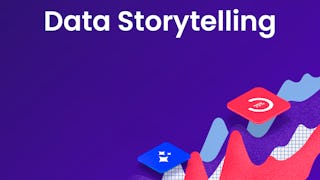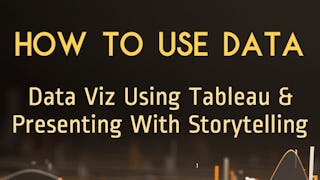This course will cover the more complex concepts that become involved when working beyond simple datasets. Exploring the connection between visual aspects and data understanding, we will examine how those concepts work together through data storytelling. After reviewing key points on how to avoid problematic visualizations and data misrepresentation, you will continue working in Tableau performing multivariate descriptive analysis of the S&P 500 stock sectors.



Data Storytelling
This course is part of Use Tableau for Your Data Science Workflow Specialization

Instructor: Majed Al-Ghandour
4,403 already enrolled
Included with 
Details to know

Add to your LinkedIn profile
4 assignments
See how employees at top companies are mastering in-demand skills

Build your subject-matter expertise
- Learn new concepts from industry experts
- Gain a foundational understanding of a subject or tool
- Develop job-relevant skills with hands-on projects
- Earn a shareable career certificate


Earn a career certificate
Add this credential to your LinkedIn profile, resume, or CV
Share it on social media and in your performance review

There are 4 modules in this course
For all but the simplest datasets, complex analytics requires a multivariate understanding of the data being studied. Visual interactivity with the data is a key component of multivariate analytics and makes finding higher dimensional relationships in complex datasets more intuitive. In this module, we’ll take a look at various chart types and visualizations used to express comparisons. You will also have the opportunity to practice correlations in Tableau.
What's included
2 videos4 readings1 assignment1 discussion prompt
How important do you think interaction is for general audiences to gain an understanding of complex data sets? In this module, we’ll explore how visual interactivity with the data makes higher dimensional relationships in complex datasets more intuitive and debate whether interactivity in visualization is a hindrance or help for larger audiences.
What's included
4 videos3 readings1 assignment1 discussion prompt
Why does storytelling matter when delivering data to your audiences? What are the principles of storytelling that you should implement into your visuals? In this module, we’ll examine aspects of storytelling and how to structure your story to effectively communicate the right insights to your key stakeholders.
What's included
1 video4 readings1 assignment1 discussion prompt
Any time we create a visualization, we create an abstract model of the data. As designers, we must ensure that the data is represented as truthfully and objectively as possible because they have the ability to mislead, deceive, or confuse. In this module, we’ll take a look at some problematic visualizations and how to avoid misrepresenting data. You’ll also put your knowledge to use and perform multivariate visualization methods in Tableau.
What's included
4 readings1 assignment1 peer review1 discussion prompt
Instructor

Offered by
Recommended if you're interested in Data Analysis


Fractal Analytics


DeepLearning.AI


University of California, Irvine


University of Pennsylvania
Why people choose Coursera for their career




New to Data Analysis? Start here.

Open new doors with Coursera Plus
Unlimited access to 10,000+ world-class courses, hands-on projects, and job-ready certificate programs - all included in your subscription
Advance your career with an online degree
Earn a degree from world-class universities - 100% online
Join over 3,400 global companies that choose Coursera for Business
Upskill your employees to excel in the digital economy
Frequently asked questions
Access to lectures and assignments depends on your type of enrollment. If you take a course in audit mode, you will be able to see most course materials for free. To access graded assignments and to earn a Certificate, you will need to purchase the Certificate experience, during or after your audit. If you don't see the audit option:
The course may not offer an audit option. You can try a Free Trial instead, or apply for Financial Aid.
The course may offer 'Full Course, No Certificate' instead. This option lets you see all course materials, submit required assessments, and get a final grade. This also means that you will not be able to purchase a Certificate experience.
When you enroll in the course, you get access to all of the courses in the Specialization, and you earn a certificate when you complete the work. Your electronic Certificate will be added to your Accomplishments page - from there, you can print your Certificate or add it to your LinkedIn profile. If you only want to read and view the course content, you can audit the course for free.
If you subscribed, you get a 7-day free trial during which you can cancel at no penalty. After that, we don’t give refunds, but you can cancel your subscription at any time. See our full refund policy.
More questions
Financial aid available,

